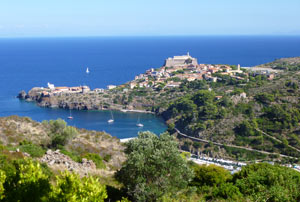Capraia tourist information
Capraia (Isola di Capraia) is a small Italian island off the coast of Tuscany. It has protected national park status, and is extremely unspoiled and rich in wildlife. With hillside footpaths and lovely views, Capraia is a great get-away for hikers and nature-lovers. The island’s rocky coves are popular with sea bathers, while there are boat trips and hire boats for those wanting to explore the coastline. Capraia is reached by daily ferries from the Tuscan port Livorno, close to Pisa (see below for more transport information).
Capraia in detail
Capraia lies 34 miles off the west coast of Italy. The island is 5 miles long and 2.5 miles across at its widest point, and the vast majority of its surface consists of wild and unspoiled hills, marked only by the traces of ancient agriculture. The western coast of the island is steep and rocky while the eastern shore – where the port is situated – descends to the sea in gentler hills and valleys. Capraia has an official resident population of 400, although this rises in summer, and shrinks to just 80 over the winter. For more than a hundred years the island was the site of a prison colony, where convicts lived in settlements in the hills and farmed the slopes. After this closed in 1986, the island was thankfully protected from over-development by the creation of a national park.
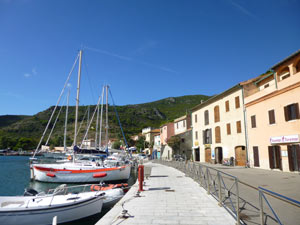
Things to see on the island include the abandoned penal colony – one of the island’s most popular walks (more below) traverses through the ruined buildings and agricultural complexes which were part of the extended prison. Other walks from town include sights like the ancient ruinous church of Santo Stefano, near the island’s modern vineyard at La Piana, and a small lake which is an unusual feature for an Italian island. Capraia is a paradise for botanists and bird-lovers; it has several endemic species and a huge range of typical Mediterranean plants and shrubs. The island’s principal habitat is the characteristic Mediterranean shrubland known as macchia (maquis). Spring and early summer is the best time to visit for wildlife, but even in autumn there are flowers blooming as well as berries, birds and butterflies. Look out for the huge dark butterfly known as the Two-Tailed Pasha, which lives on the strawberry tree, the mouflon (wild horned sheep) which roam the hills, the gulls and ravens which live on the island and migratory birds which pass through. Dolphins and whales are occasional visitors to the island’s waters.
Capraia’s two settlements are the port (Porto) and the historic village (officially Capraia Isola, generally referred to locally as the Paese, or village). The village is on a headland, clustered at the foot of a fortress – the Forte di San Giorgio – built to defend against pirate attacks. Unfortunately the fort is in private ownership, and its buildings have recently been subject to an unsympathetic restoration. On a promontory below the village is a watchtower and a picturesque abandoned monastery. The port and the village are connected by a little bus (tickets from the driver) which runs continuously in summer and once or twice a day for the rest of the year. The bus stops by the ferry when it arrives; its regular stop is further inland, in a small parking lot. The road rises gently from the port, and it is a pleasant 15-minute walk to connect the two settlements. Tourist information and maps can be picked up at the Pro-Loco office which is situated by the port, on the road which heads inland before curving to climb the far side of the bay (note that opening hours are seasonal and the office is likely to be closed for several hours in the afternoon).
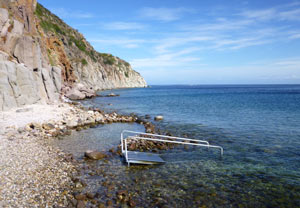
There are one or two shops, including a grocery, in each settlement, as well as two or three restaurants. Seafood is the island’s speciality. Alongside the castle, La Garitta is a popular and pleasant restaurant for an evening meal in classy surroundings, offering seafood, pasta and excellent desserts. The port is the best place to start your evening, with a glass of wine near the harbour. Restaurants by the port include Il Vecchio Scorfano, where you can eat seafood while looking out over the boats. Travellers should make a point of sampling the island wine from the La Piana vineyard, which has a little kiosk by the port. Created in the last few years, the vineyard has revived agriculture on the island, re-cultivating overgrown terraces. The organic wines include a white Vermentino, a pink rosato and a good sweet red passito.
A great introduction to Capraia is to wander up through the streets of the village, turn right at the castle walls and follow the lane out past the island’s heli-pad. A path winds along the cliff a short distance to the Bellavista viewpoint, which has panoramic views over the sea, across to Elba, and back over the fortress on its rocks; hugely dramatic from this angle. Even on this short stroll you will see some of the island’s characteristic wildlife, from flowers to birds. There are benches where you can enjoy the view. Opposite the heli-pad, alongside a large modern terrace, a steep path climbs down to the rocky shore, where a tall and narrow tower stands, built as defensive adjunct to the castle. The old route from port to village, signposted at the foot “Vecchio strada”, is a pleasant alternative to the modern road, an attractive mule path climbing rather more steeply than the modern road.
A boat trip around the island takes around two and a half hours and is a good way to see Capraia from every angle. Trips are operated by two agencies with offices alongside the port, the Agenzia Parco and Agenzia della Rosa. Note that some of the excursions are carried out in small rubber boats (gommoni). It is also possible to hire your own boat, though an organised trip will be a good way to familiarise yourself with the coastline beforehand.
Walking and swimming on the island
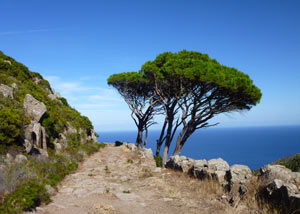
Capraia is one of the few places in Italy where hiking is a normal – indeed, a majority – activity for visitors. Rucksacks, walking poles and cargo shorts are all common sights. On arrival, travellers should pick up the island’s map of walking routes (available in hotels and at the “Pro-Loco” tourist information office by the port) and perhaps, if you read Italian, a guidebook containing fuller descriptions. Local people are also good sources of up-to-date information. The day on Capraia usually begins with a trip to the mini-market (there is one by the port and one in the village) for a filled roll and bottles of water. Equipped with lunch, you have a choice of footpaths to follow. These have been created or restored from the island’s old network of mule paths; most have stony surfaces and gentle zigzagging gradients, although some involve considerable climbs. There is some signposting, although it is a bit hit-and-miss. Guidebooks and maps will give you estimated times for each excursion (I found these to be generous but they may vary). Hikes range from the delightful Reganico circuit near the village (only around an hour), which passes through a pretty valley packed with interesting Mediterranean plants and flowers, to expeditions of five hours or more which climb to the island’s summits and viewpoints. One of the most interesting walks climbs in zigzags from the small church behind the port and passes through the ruins and terraces of the old penal colony. Continuing to climb in zigzags, the path has wonderful views over the port and village. Taking an upper option past an old barn, the route winds on through other isolated and abandoned prison farmsteads, past rejuvenated agricultural terraces recently reclaimed to grow vines, and clambers up to a viewpoint called the Dattero.
In breaks from walking, Capraia’s visitors take dips in the sea, or sunbathe on rocks. The easiest sea access is right beside the port, where locals swim from a little pebble beach (pictured below). There are no large or comfortable beaches on the island (one remote bay sometimes boasts sand, depending on the winds), but there is one equipped bathing establishment, opposite the port beneath the watchtower, where sunbeds are arranged on a concrete platform. There are also a number of rocky coves accessible by steep footpaths. Sea swimming is generally from ladders or rocks, and best suited to confident swimmers. As the accessible coastline is on the eastern side of the hilly island, note that the sun can disappear from sea-level rocks during the course of the afternoon. A couple of the island’s hotels (see below) have swimming pools.
If you are keen on wildlife I’d suggest taking identification books and binoculars. For walks in the summer months, hats, sun-lotion and plenty of water are important. Walking boots or very strong shoes are advisable for the footpaths and mule tracks.
Ferries to Capraia
Ferries to Capraia are operated by Toremar. There is a daily early-morning service from Livorno, generally 8:30am at the time of writing, although this can vary. There are also occasional afternoon ferries. The crossing takes around two and three-quarter hours, passing near – and occasionally calling at – the rocky prison island Gorgona. Although the ferry transports vehicles as well as foot passengers, there is just one road on Capraia and no need for visitors to take a car. The ferry is well-equipped with indoor and outdoor seating, a snack bar and toilets.
The timing of the ferries means that international travellers will usually want to spend a night in Livorno prior to catching the boat. Convenient hotels include Hotel Gran Duca (barely five minutes from the ferry) and the good-value central Hotel Europa Parking. The Toremar ferry departs from the Porto Mediceo, an easy walk from the centre of Livorno (readers should confirm the latest details online in advance). Toremar have a ticket office opposite the quay.
Pisa Airport is very convenient for the island; there is a rail station at the airport and trains to Livorno (with a change at Pisa Centrale) take around 40 minutes. Livorno is around twenty minutes by train from Pisa Centrale. Livorno station is connected with the centre of town by bus number 1, which cuts right through the heart of town and stops close to the Porto Mediceo. Buy your bus ticket at one of the shops in the station, and don’t forget a spare ticket for your return journey.
Although Capraia is closer to Elba and to French Corsica than it is to the Italian mainland, there are at the time of writing no scheduled ferry connections between the islands. Occasionally in summer full-day boat excursions may be arranged.
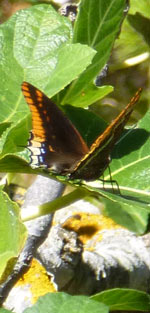
When to visit and for how long
In a three-night visit you can sample everything Capraia has to offer: a walk, a boat trip, restaurants, swimming. There are enough walking trails to fill five days or a week comfortably. Visiting for one night, you could still accomplish a good walk and a taste of the island.
Hotels tend to close down over the winter; the official summer season (when you will find swimming pools open, longer boat tours and bus services) begins around 15 June and lasts until 15 September. Outside that period the bus runs only to meet the ferry. You can still find good weather and accommodation in the shoulder seasons, and the island in fact participates in a walking festival in the autumn and spring.
Accommodation
There is very little accommodation on Capraia, so you should book ahead. Il Saracino has a pretty sun terrace with a lawn and a salt-water pool. Residence La Vela offers apartments by the fortress and Max Resort La Mandola has another salt-water pool. All three are situated in the village, and typically the hotel driver will meet the ferry to welcome guests and take your luggage up to the hotel for you (guests may be expected to walk or catch the bus).
On this site
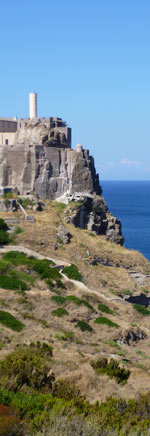
Useful links
Capraia accommodation (Booking)
Tuscan Archipelago National Park
